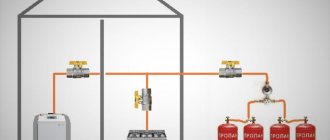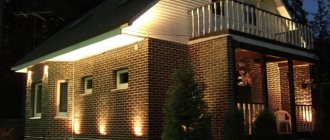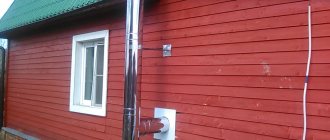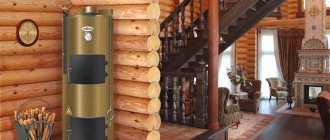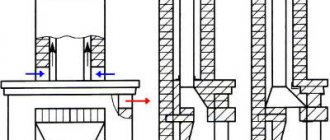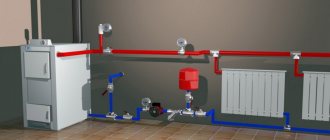Humanity has always been in search of cheap energy and our time is no exception, but for now we have to be content with what we have. Therefore, in places where there are no centralized lines, residents are looking for how to connect a gas boiler to a propane cylinder. Most often, for them this will be the most optimal option for solving the problem of heating a country house or cottage.
Connection diagram of an LPG boiler to a heating system Source strojdvor.ru
But, before buying a boiler and cylinders, it would not hurt to understand how such heating systems work and what will be most practical and profitable in a particular case. We are not talking about the impossibility of providing heat to a large or small residential building at all, since this can be done in any case. You just need to understand that not only boilers are different, but also heating circuits, on which gas consumption depends.
Important: before you start installing a heating system in a country house or dacha, you need to remember that boilers using bottled gas are not produced at all! To operate the unit on LPG, you will have to make some changes to the burner and nozzles.
Differences between liquefied and natural gas
Phases of liquefied gas in a cylinder Source otivent.com
Everyone knows that methane (CH4) predominates in the composition of a liquefied hydrocarbon mixture (hereinafter referred to as LPG). Its hydrogen (H) content is about 55%, so methane releases more heat per unit mass when burned than any other organic substance. LPG for boilers, water heaters and internal combustion engines is a homogeneous mixture of propane (C3H8) and butane (C4H10). The priority of natural gas over LPG mainly lies in its cheapness - this parameter prevails even over the high efficiency of methane during combustion.
Physical properties of propane-butane:
- heat release during combustion – 6.4 kW/1 dm3;
- under pressure, natural gas easily passes into the liquid phase and vice versa;
- LPG is pumped from storage into standard cylinders or gas tanks;
- for combustion in nozzles and cylinders of internal combustion engines, propane-butane is supplied in a gaseous state;
- As LPG is used, condensate accumulates at the bottom of the tank, as an inevitable element that occupies useful volume.
The containers into which LPG is pumped are never filled to capacity. 20% of the tank is always left empty to allow propane-butane to go into gaseous form. In standard cylinders, the net capacity is 40 liters, with the ability to pump 50 liters.
Heating a house 100 m²
Really, honestly, really
| Heating a house 100 m² from | RUR 49,500 |
| Installation of heating boiler | 8,000 rub. |
| Installation of heating radiators (no more than 10 pieces)!!! The cost of installing a standard (mounted, not in-floor convector) heating radiator is 4,000 rubles | 25,000 rub. |
| Radiator pipe routing | 12,000 rub. |
| Pressure testing and filling with coolant | 4,500 rub. |
| TOTAL turnkey: | RUB 49,500 |
| Drilling holes, rigging, dismantling, paid extra | according to_estimate |
Heating a house 100 m² Attention. This cost is a preliminary estimate; these prices should only be used as approximate prices. The exact cost of the work is calculated after an engineer visits the work site, its complexity, and quantity.
Cost of materials from 120,000 rubles
General requirements for cylinders and boilers
First of all, you should take into account the location of the rooms in the house. If there is a boiler room there, this does not mean that technical issues with the room have already been resolved, since gas cylinders cannot be in the same room with the heating device! For this purpose, you will have to equip some kind of kitchen, bedroom, etc. or make a cabinet against the wall of the building where containers will be stored. You can also dig a hole in the yard and install a steel tank there as a home gas tank.
Efficiency
Efficiency is one of the most important parameters of a heating system. Liquefied gas is more expensive than main gas, and transportation costs must be added to its cost.
Therefore, when purchasing a boiler, you need to calculate the consumption of cylinders, taking into account the efficiency of the entire heating system.
The efficiency of modern, working equipment can reach 90-95%. To calculate gas consumption for heating, you need to know the total area of the room: approximately 1 kW of power is consumed per 10 sq.m.
Heating and water heating in a country house of 100 sq.m will require about 2 cylinders per week and 8-9 cylinders per month. You can connect cylinders into a group: according to the rules, the use of a cylinder system of up to 15 pieces is allowed. In this case, gas containers must be located in a closed metal cabinet.
Requirements for boilers
On the left - convection (traditional), on the right - condensation Source otivent.com
Before buying a heater to operate on LPG, you should remember that a gas boiler using gas cylinders will only function if the unit is capable of operating at a reduced pressure from 0.003 to 0.004 bar or from 2.96 to 3.94 atm. Otherwise, no fundamental changes to the equipment will be required. If this is the case, then in the technical passport of the boiler from the manufacturer there is always a section that indicates the operating conditions for liquefied gas.
Important: even if you thoroughly understand the settings and convert the unit yourself, you should not put it into operation! Before start-up, contact a nearby public or private enterprise so that the reconfiguration of the equipment can be inspected by a licensed specialist.
Selecting a boiler for conversion to LPG
Heaters differ in mounting methods Source otivent.com
Manufacturers of any gas boilers set themselves the task of increasing the efficiency of the unit as much as possible, and this, first of all, depends on the complete combustion of fuel in the system. Despite the difference in the state of methane and liquefied hydrocarbons, the principle of their combustion is no different from each other, but there are some nuances that will have to be taken into account. It should be remembered that it will not be possible to use both energy carriers (LPG and methane) at the same time, since the reconfiguration process involves partial disassembly of the boiler with the replacement and reconfiguration of some components and parts.
To select and purchase a gas boiler, you need to consider the following:
- Power. For every 10 m of residential premises with ceilings no higher than 2.7 m, 1 kW will be needed, but if the rooms are higher, then you need to calculate by volume: for every 10 m3 - 0.41 kW. Then the resulting power must be multiplied by a factor of 1.2 - this is the simplest and most reliable method of calculation.
- If the house does not have a chimney, or rather, there is no way to use it for your heater, then choose a suspended model with a closed combustion chamber. There, combustion products exit through a coaxial pipe, which is discharged through the wall directly next to the boiler.
- If your house still has a chimney, but you don’t have a lot of money, without any doubt, take a model with atmospheric draft (open combustion chamber). Such a unit will be cheaper and without losing the efficiency of heating the house.
- If you choose a double-circuit boiler, make sure that the heat exchanger is separate (one for heating, the other for DHW). This option is more convenient to maintain and more reliable in operation. Also, for a budget option, you can buy a parapet boiler - there is a coaxial pipe with the combustion chamber open, but the most powerful of them is no more than 12 kW.
We reconfigure the floor heat generator
Non-volatile boilers of the AOGV type, equipped with automatic equipment of the 630 SIT and 710 MiniSIT series, are converted to liquefied gas in the same way as their wall-mounted “brothers”. The transition is made in 2 stages - installing new jets and subsequent pressure adjustment.
The burner on most units is removed along with the mounting plate and safety automatics
We will not consider disassembling and dismantling the burner - this topic is covered in detail in the publication on cleaning gas heaters. Install the nozzles from the liquefied gas kit and proceed to setting:
- Remove the top plastic cover from the 630 SIT valve. On the right side, find the screw for adjusting the fuel pressure supplied to the main burner.
- There are 2 fittings located on the left side of the automation unit. Connect the pressure gauge to the upper branch pipe, first unscrewing the plug.
- Light the boiler and turn the burner to maximum mode, setting the power control washer to the number “7”.
- By rotating the screw clockwise, increase the pressure of the propane mixture to the desired value (usually 26-28 mBar).
Warning. After unscrewing the plug, gas comes out of the fitting with a quiet hiss. To minimize leakage, quickly put on the hose that goes to the pressure gauge.
The igniter flame is regulated by a small screw located on the upper plane of the automation (see photo). Reduce the burning intensity, but do not overdo it, otherwise the wick will go out due to gusts of wind from the chimney. The pressure in gas convectors equipped with valves 710 MiniSIT and 630 SIT is adjusted in a similar way.
Gas cylinders
Connecting cylinders
A special reducer is used to regulate the pressure Source stroyinstal.ru
Connecting liquefied propane-butane is carried out in exactly the same way as connecting natural methane, but given the fact that the LPG pressure is higher, there should be a reducer at the outlet of the manifold from the cylinders. Only it’s not the same as what you’re used to seeing when connecting a gas stove at the dacha, although the essence is the same - it’s adjusting the pressure. In our situation, it is a device with a regulator and a pressure gauge.
Advantages
Each heating method for a private home has its own advantages and disadvantages. Knowing about them, you can decide whether one or another method is suitable for a particular home. Advantages of gas cylinder heating:
- Inexpensive fuel price. Today the cost of gas is not the most expensive in the energy market.
- Availability. Not every locality has a gas pipeline. Gas cylinders can be bought at any construction hypermarkets and pumped at special stations.
- Autonomy. Can be installed separately and does not depend on external factors. Connection does not require a gas line. The cylinder can be brought anywhere.
- Stability . Fuel is supplied under a certain pressure. It does not jump in the pipes and does not change, it flows evenly.
- Durability. The cylinders last a long time and can be refilled many times. If necessary, all equipment can be resold on the secondary market without any problems.
- Heating water. Another plus is the ability to provide the house with hot water.
Is it possible to somehow save liquefied gas consumption?
Such a sensor is installed in a boiler room Source tion.ru
Yes, it is indeed possible if you follow all the recommendations and rules. There are not many of them, but they still exist and help save the family budget for those who adhere to them:
- Insulate the house. External insulation turns out to be more effective than internal insulation.
- Replace old windows and doors with new ones so that the shutter strips fit tightly in all places, preventing cold air from entering from the street.
- The difference in air temperature in the boiler room and the heated room should not exceed 2-3°C. To do this, in the room where the boiler is installed, you can even put a homemade register welded from a metal profile.
- Refill cylinders and tanks only at proven gas stations so that there are no foreign impurities in the LPG.
- Use automation to regulate the temperature in the heating circuit. Its indicators must correspond to the desired air temperature in the room.
- Install a monitoring sensor that detects carbon dioxide leaks. If there is one, then you will have to constantly ventilate the boiler room, which means additional costs for heating the room.
Important nuance
There are two types of gas used in everyday life. More precisely, two compositions of the gas mixture. And the characteristics of these mixtures differ greatly:
Main gas, which consists of methane with an indicator - a strong-smelling component that allows you to quickly detect a leak. The main difference is that the mixture is lighter than air. Therefore, in a properly made furnace, a leak in the fittings is not a problem - the gas will simply go through the direct-flow system into the pipe, onto the street. A mixture of propane and butane is what is “packed” into cylinders at gas filling stations. This blend is better known as liquefied domestic gas
An important difference is that it weighs more than atmospheric air. As a result, in the event of a leak, it becomes very dangerous, since it can accumulate in the room or firebox of a stove converted to gas.
And even the presence of a gas tank does not help - the same propane-butane mixture is filled into it.
Accordingly, if there is a gas main near the house, you can make a project, a permit and bring the pipe into the house. And instead of a boiler with a system of pipes, batteries or water circuit registers, install a furnace in which to burn gas.
But if only a bottled gas supply option is available, then there is no place for homemade products. We need to go a little different way.
Flaws
As you can see, gas heating has many advantages. But, of course, it was not without its drawbacks. Although they are few in number, they are significant:
- Unfavorable heating method
Judging by the reviews, a system with gas cylinders can cost a pretty penny. According to the calculations of those who have tried it, 25 cylinders are needed for the winter, provided that the house area is 145 m2, the foundation is USP, the floors are warm, the temperature is set at +23°C, and 20 kg of fuel is pumped into 50 liter cylinders. Outside, the air temperature ranged from -5°C to -27°C. The average monthly temperature outside was -16°C.
- Effect of frost
If the cylinders are installed outside the house, the system may shut down due to frost. The reason is simple - the condensate freezes and prevents gas from flowing to the heating system.
- High safety requirements
If installing cylinders is not a very complicated procedure, then the safety measures that must be observed when placing and operating liquefied gas require strict implementation. They will be discussed further.
Is it economically profitable?
Statistics show that heating a 100 m2 building requires an average of 15 liters per day. But this parameter can vary significantly. It all depends on how insulated the house is, as well as on the air temperature outside.
Cylinders are available in different volumes: 50 l, 27 l, 10 l, 5 l. For heating a house, it is more advisable to take the largest volume - 50 liters. It holds 35-40 liters of gas. Now let's look at a simple example. To heat a house with an area of 70 m2 you will need about 2-3 cylinders for 1 week. This is provided that the temperature outside the window is -5°C. If it drops to -20°C, then heating the same house will take 5-6 cylinders for 7 days. As the square meters of housing increase, gas consumption increases proportionally.
If we add to this value the cost of gas refueling and delivery services, then heating turns out to be economically unprofitable. In addition, if the house is poorly insulated, then heat loss will increase. Accordingly, more gas will be required for home heating.
